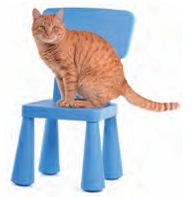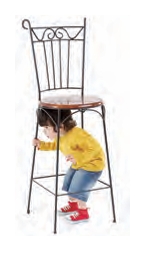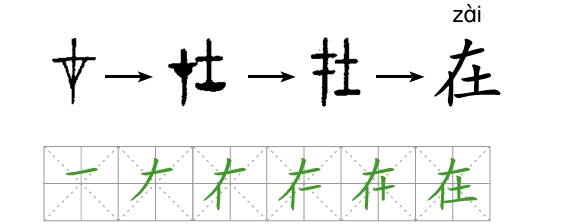HSK 1 Unit 9 Where does your son work? B
练习内容
练习 Exercises
-
分角色朗读课文 Role-play the dialogues.
-
根据课文内容回答问题。Answer the questions based on the dialogues.
- 小狗在哪儿?Xiǎo gǒu zài nǎr?
- 他在哪儿工作?Tā zài nǎr gōngzuò?
- 他儿子在哪儿工作?Tā érzi zài nǎr gōngzuò?
- 她爸爸在家吗?Tā bàba zài jiā ma?
- 她爸爸在哪儿呢?Tā bàba zài nǎr ne?
-
用本课新学的语言点和词语描述图片
Describe the pictures using the newly-learned language points and words.

________ zài ________ 。
______ 在 ______ 。

________ zài ________ 。
______ 在 ______ 。

Wǒ māma shì ________ ,tā zài ________ 。
我 妈妈是 ______ ,她在 ______ 。

Wǒ nǚ’ér shì ________ ,tā bù ________ 。
我 女儿是 ______ ,她不 ______ 。
拼音与汉字学习
拼音 Pinyin
双音节词语的声调搭配(4):四声和各声调的搭配
Tone Collocation in Disyllabic Words (4): 4th tone + 1st/2nd/3rd/4th tone

miànbāo
面包 |

miàntiáo
面条 |

diànnǎo
电脑 |

diànhuà
电话 |
听录音并跟读,注意声调的搭配 09-4
Listen to the recording and read after it. Pay attention to the collocation of tones.
xiàtiān qiūnián tiào wǔ shuì jiào
diàndēng diànchí diànyǐng diànshì
chàng gē fùxí Hànyǔ Hànzì
jiànkāng dìtú dìtiě jiàn miàn
汉字 Characters
1 认识独体字 Single-Component Characters
(1)“在”,字形像草木初生于土上,现在意思是“存活、存在”。
The original form of “在” is like grass sprouting from the earth. Now it means “to live/ exist”.
汉字知识内容
(2) “子” ,本义是婴儿,现在意思很多,如 “儿子”、“电子”。
“子” originally meant “baby”. Now it has many meanings, such as “儿子(son)” and “电子(electron)”.

(3) “工” ,字形像工匠的曲尺,现在意思很多,如 “工人”、“工作”。
“工” was originally shaped like a craftsman’s zigzag ruler. Now it has many meanings, such as “工人(worker)” and “工作(to work; job)”.

2 汉字结构(4):半包围结构 Structure of Chinese Characters (4): half-enclosure
合体结构中还包括半包围结构和全包围结构(见第10课),本课的半包围结构又分为两面包围结构和三面包围结构。
There are another two kinds of compound structures—the half-enclosure structure and the enclosure structure (see Lesson 10). The half-enclosure structure in this lesson includes the structure enclosed by two sides and the structure enclosed by three sides.
| 结构 Structure |
例字 Example Characters |
图解 Illustrations |
半包围结构
half-enclosure |
店 diàn store
习 xí to study
这 zhè this
同 tóng same
凶 xiōng fierce
医 yī doctor
|
店
习
这
同
凶
医
|
汉字偏旁及运用
3 汉字偏旁 “辶” 和 “门” Chinese Radicals: “辶” and “门”
偏旁
Radical |
解释
Explanation |
例字
Example Characters |
| 辶 |
走之旁,一般和走路有关系。
The radical “辶” is usually related to “walking”. |
这 zhè this
送 sòng to send |
| 门 |
门字框,一般和房间、房门有关。
The radical “门” is usually related to a room or a door. |
问 wèn to ask
间 jiān a measure word for rooms |
运用 Application
1 双人活动 Pair Work
两人一组,根据实际情况进行问答练习。
Work in pairs and ask and answer questions according to the actual situations.
例如: (1) A: ……在哪儿?
zài nǎr?
B: ……在……
zài
(2) A: ……在哪儿工作?
zài nǎr gōngzuò?
B: ……在……工作,他/她是……
zài gōngzuò, tā/tā shì
小组活动
2小组活动 Group Work
3~4人一组,互相介绍自己的朋友、同学的工作情况并记录,每组请一位同学报告情况。
Work in groups of 3 – 4. Tell each other about the jobs of your friends or classmates and take notes Each group chooses one member to make a report.
|
朋友/同学
Friend/Classmate |
工作
Job |
| 1 |
李朋
Lǐ Péng |
是医生,在医院工作。
Shì yīshēng,zài yīyuàn gōngzuò. |
| 2 |
|
|
| 3 |
|
|
| 4 |
|
|
















Comments